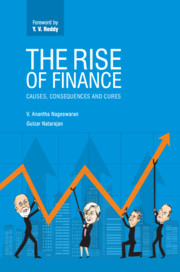4 - The Monetary Policy Framework
from Part B - The Consequences
Published online by Cambridge University Press: 02 May 2019
Summary
This chapter is a continuation of Chapter 3 in the sense that we are still wrestling with the consequences of financialization. In a sense, the previous chapter was about social consequences whereas Chapters 4 and 5 are about consequences of financialization on the economy, on capital markets and on systemic risk, acting through monetary policy.
We had noted earlier that Alan Greenspan favoured and championed deregulation of finance. But once deregulation became a fait accompli, the importance of finance to the economy grew and the financial sector became a formidable political and economic force. Therefore, policymakers came to the conclusion that what was good for finance was good for the economy. Consequently, monetary policy was tailored to ensure that it encouraged and did not impede financial sector activity and financial markets.
This needed an intellectual framework. The experience of the 1970s came to the rescue. In the wake of the twin oil price shocks, labour militancy and turmoil in the Persian Gulf, economic growth stagnated but the inflation rate rose sharply in many parts of the advanced world. We had recorded earlier that it gave rise to the neoliberal agenda that put the interests of capital and capitalists at the top and centre of economic policy. Monetary policy had to focus on price stability. Inflation had to be leashed. Since labour costs are the largest portion of cost of production, restraining wages became the prerequisite for preventing inflation from running up. Hence, at the first sign of acceleration in wages, central banks applied the monetary brakes and raised interest rates. The balance between labour and capital had tilted in favour of the latter.
Since central banks were responsible for the creation of money, it appeared logical to give them the responsibility to preserve the value of money. Is it really the case that money supply was the determinant of inflation? It might have been the case when Friedman and Anna Schwartz examined the data and proclaimed that inflation was always and everywhere a monetary phenomenon. But did it hold true in the modern era when the introduction of credit cards and electronic payments had upended the traditional role of money?
- Type
- Chapter
- Information
- The Rise of FinanceCauses, Consequences and Cures, pp. 64 - 98Publisher: Cambridge University PressPrint publication year: 2019



